The number of Wisconsin high school students who participate in dual enrollment programs continued its decade-long growth in the 2023-24 academic year, hitting a new record. A combined 78,703 students participated in the dual enrollment programs offered by the University of Wisconsin and Wisconsin Technical College systems, through which they could earn credit at higher education institutions as well as their high schools. This represents more than a quarter (26.6%) of the state’s secondary students across public, private, and home schools, and it is a 3.4% increase over the previous year (see Figure 1).
The Wisconsin Technical College System (WTCS) offers the largest dual enrollment program in the state, enrolling more than four times as many students as the one operated through the University of Wisconsin System (UW). From 2022-23 to 2023-24 (referred to in this brief as 2023 and 2024), however, the UW program grew at a faster rate — by 12.0% to 15,588 students — than the WTCS program, which increased by 1.5% to 63,115 students. Both systems offer an array of programs to meet the various needs of high school students, which sometimes results in similar, parallel programs in each system. In this analysis, individuals who took classes in both systems are counted twice but are unduplicated if they participated in multiple programs within one system.
In our previous report on dual enrollment, we examined participation in the programs using data provided by the state’s two public college systems. Since then, the Wisconsin Department of Public Instruction has added postsecondary preparation programs to its annual report cards for high schools. These programs, which include dual enrollment and Advanced Placement (AP), equip students for higher education or the workforce. With this new information, we are now able to examine participation levels by high school in dual enrollment and other postsecondary opportunities.
Advanced Placement is not a dual enrollment program, but because it also exposes high school students to college level material, the programs are often discussed together. The AP program is a nationwide system in which students take courses to prepare for end-of-year standardized tests in various subjects. Based on the scores of those exams, colleges may grant students college credit when they enroll.
The AP participation rates on the school report cards also include those who participate in International Baccalaureate (IB), another rigorous pre-college program. The AP program is much more prevalent in Wisconsin schools than IB, and schools usually do not have both. In this brief, any reference to the AP rate also includes IB participation, as the two cannot be separated based on the information provided in the school report cards.
School Participation Rates
To understand dual enrollment and AP participation trends across Wisconsin, we analyzed information from school report cards for 551 high schools that reported on postsecondary program participation in the 2022-23 school year. The vast majority are public high schools, which are required to report these statistics. A few schools that teach grade levels below ninth grade, such as combined junior-senior high schools, are also included.
The report cards indicate that, in 2023, 85.7% of Wisconsin’s public high schools (including charters) offered dual enrollment programs, and 73.9% had AP courses. Both programs were offered in 68.4% of schools. Schools were more likely to have dual enrollment courses if they were large and had lower rates of poverty. Schools in cities were somewhat less likely to offer them than those in suburbs, towns, and rural areas.
Figure 2 shows the proportion of schools that offered dual enrollment, as well as AP programs, based on their sizes and locales. (Locale refers to whether a school is located in a city, suburb, town, or rural area as defined by the National Center for Education Statistics.) Medium and large schools, defined as those with more than 400 and 1,000 students respectively, were highly likely to offer both AP and dual enrollment classes regardless of where they were located. Small schools with 100 to 400 students and very small schools with fewer than 100 students were less likely to have postsecondary programs, but the rates differed by locale. If a smaller school offered one of these opportunities, it was more likely to be dual enrollment than AP, especially for schools in rural settings.
The likelihood of a school’s participation in dual enrollment was also tied to the economic status of its student body. Only half of the schools in which 75% of the students were from economically disadvantaged households offered dual enrollment programs, compared to 91.1% of the schools where less than a quarter of students were economically disadvantaged.
Schools that were the least likely to offer dual enrollment courses were typically small, urban, or with high rates of poverty, or shared multiple of these characteristics. The notable exceptions — large, wealthy schools with low rates of dual enrollment — often had strong participation in AP or IB programs instead. These schools were large enough to support robust AP or IB programs, and many of their students planned to attend private or out-of-state colleges.
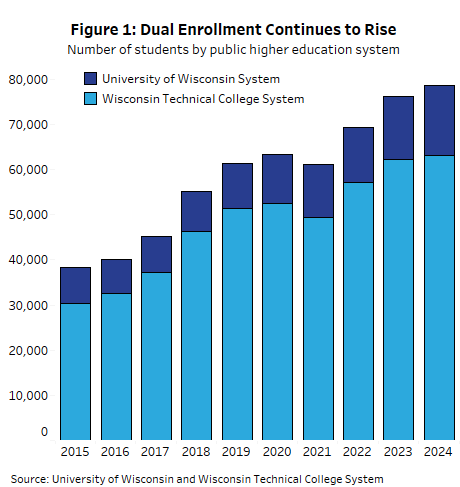
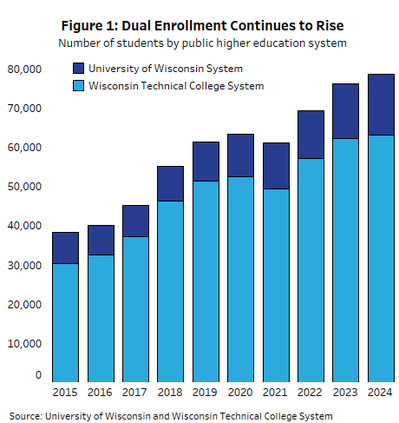
Student Participation Rates
The 472 public high schools that reported providing dual enrollment opportunities in 2023 enrolled 259,286 students, and 68,151 of them (26.3%) took advantage of those opportunities.
Participation rates varied across these schools, however. Students from urban schools had the lowest rate of dual enrollment participation at 19.7%, while those in suburbs, towns, and rural communities had participation rates of 28.3%, 30.1%, and 27.6%, respectively — all higher than the state average.
Students from schools with high rates of poverty were less likely to participate in dual enrollment programs. Only 4.3% of students from schools in which more than 75% of the students identified as economically disadvantaged took a dual enrollment course. On the other extreme, schools where less than 25% of students are from economically disadvantaged families reported a dual enrollment rate of 30.5%.
Racial demographics also correlated to participation rates. Students from schools in which less than half of the students were white had a participation rate of 14.4%. The rate was much higher — 25.1% — for students at schools where more than 50% of students were white. Those schools in which more than 90% of the students identified as white had an even higher rate of 33.9%. These schools also tend to be in rural areas.
Interpreting student participation rates by school type is complex for several reasons. The first is the interaction of school characteristics. For example, dual enrollment participation is high in rural schools and low in small schools, but many rural schools are small.
Another complicating factor is the various reasons for which students participate in dual enrollment programs. Some students want access to more classes, such as advanced math or world languages, before pursuing a four-year degree. Others want to accelerate their tracks to the job market by working on career-based credentials. Yet another complicating factor, discussed more below, is whether the schools offer other programs, such as AP or IB, and the extent to which the school’s culture promotes one program over the others.
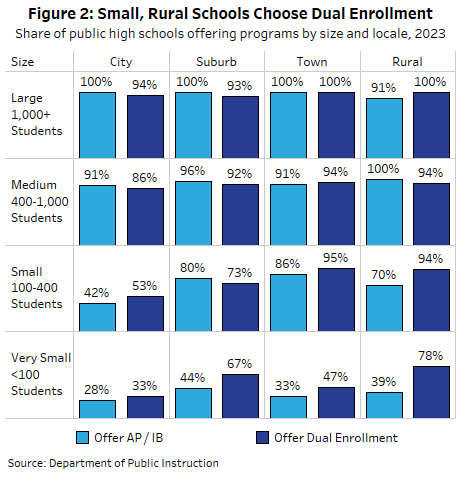
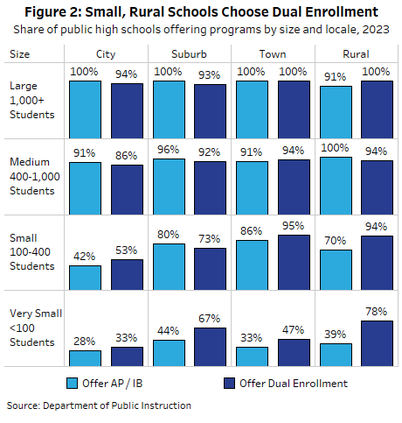
Dual Enrollment Versus Advanced Placement Programs
Advanced Placement and dual enrollment need not be in direct competition with each other. While both offer higher level coursework and the potential to earn college credit, their structures allow them to serve different purposes, often alongside one another in the same schools. A majority of Wisconsin’s public schools offer both programs because they meet the varied needs of their students.
The student participation rates of school districts are displayed below in Figure 3, with AP rates on the left and dual enrollment rates on the right. Although both programs show a range of zero participation to more than half of students participating, geographic location appears to have a greater influence on AP rates. Districts with higher rates of AP participation are concentrated in the southern part of the state, close to the metropolitan areas of Madison and Milwaukee. Districts with high rates of dual enrollment, on the other hand, are dispersed throughout Wisconsin. The distribution of the programs may be affected by the purposes they serve and their perceived value.
Advanced Placement has a strong reputation at the national level and is viewed as a more universal option for students who enroll in private or out-of-state colleges. However, the potential for a student to earn credit is based on a single, high-stakes test and whether a college accepts the AP score achieved.
On the other hand, dual enrollment programs are Wisconsin-based. The value of earned credit is easily determined within the state’s public college systems. Students who attend private colleges or leave Wisconsin can transfer dually-enrolled credit in the same manner as any other student who transfers schools. These classes may not have the same reputation as AP, but some see them as more authentic college experiences because they ascribe credit based on a semester’s work, not the results of a single exam.
The Advanced Placement classes cover general, subject-based material that aligns with liberal arts degrees. Table 1 below shows that the most popular AP classes among Wisconsin students who graduated in 2024 were in social sciences, English, and mathematics. The top courses for dual enrollment programs at UW and WTCS also included liberal arts subjects, but others were career-based with the intention of preparing students for specific occupations.
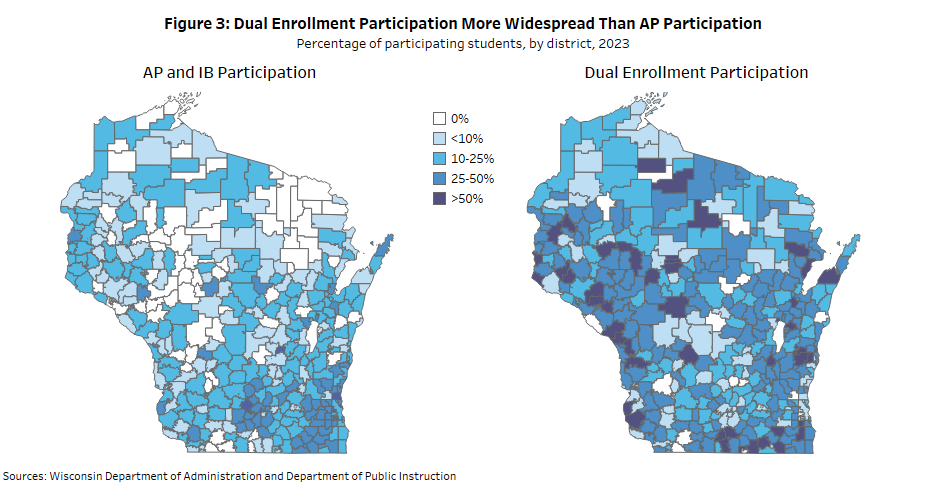
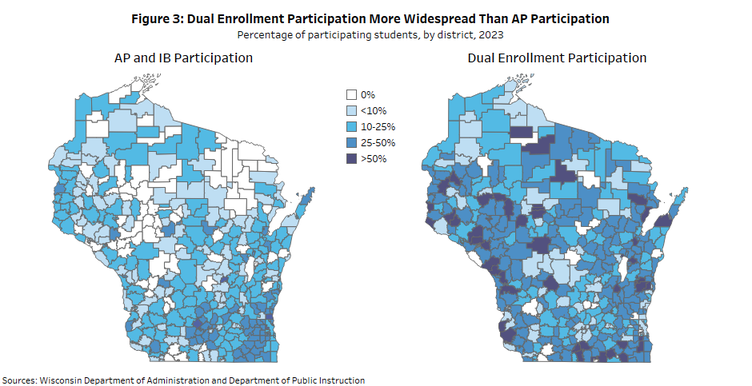
Conclusion
Providing students with opportunities for college or university coursework is a priority for Wisconsin, as demonstrated by its inclusion on the state’s school report cards and its popular adoption across high schools. Dual enrollment is the most widespread of these programs and has been steadily growing for the past decade, perhaps due to the range of benefits that dual enrollment programs offer students and schools.
Small schools with limited resources often do not offer postsecondary programs, but if they do, the programs are more likely to be dual enrollment as opposed to AP classes. The wide range of dual enrollment programs provide versatility and can therefore meet the needs of local students — whether they are pursuing college-level courses or career-based training.
Schools that offer no postsecondary opportunities, which are usually small and have high rates of poverty, may want to consider how they could work with the college systems to begin their own dual enrollment programs. Small schools would gain access to more resources and class offerings, and students from schools with high poverty rates could benefit from reduced educational costs and job-related training opportunities. As some students choose to forgo enrolling directly in a college or university after high school graduation, even as the value of higher education remains high, dual enrollment offers a compelling opportunity to accelerate preparation for both the workforce and postsecondary education.

